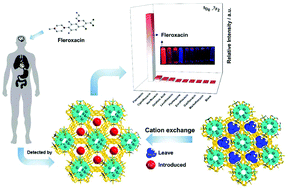A highly sensitive and selective “turn-on” fluorescent probe for detection of fleroxacin in human serum and urine based on a lanthanide functionalized metal–organic framework†
Abstract
Cation exchange, a facile and non-destructive post-synthetic modification method, is applied to [(Me)4N]2[Pb6K6(m-BDC)9(OH)2]·H2O (1) (1,3-H2BDC = 1,3-benzenedicarboxylic acid) to prepare a series of lanthanide functionalized metal–organic frameworks. The fluorescence properties of Ln3+@1 (Ln = Eu, Tb, Sm and Dy) are investigated. The results demonstrate that the framework of 1 is capable of sensitizing both Eu3+ and Tb3+ ions effectively. Remarkably, the rapid and stable fluorescence sensitization of Eu3+@1 can be observed in the presence of fleroxacin in aqueous solution, indicating that the hybrid system can be designed as a highly sensitive and selective probe for fleroxacin. As a novel “turn-on” fluorescent probe, Eu3+@1 is regarded as a promising candidate for applications in clinical diagnosis, due to its merits of high antidisturbance, chemical stability and a low detection limit (43.91 ng mL−1). In this paper, the practical application of luminescent Eu3+@1 is highlighted, and its possible sensing mechanism is also described.



 Please wait while we load your content...
Please wait while we load your content...